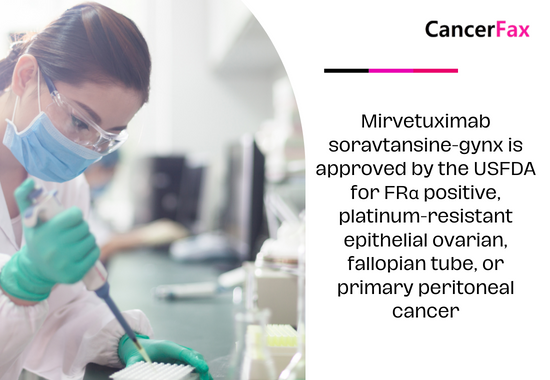March 2024: The Food and Drug Administration has granted approval for mirvetuximab soravtansine-gynx (Elahere, ImmunoGen, Inc. [now a part of AbbVie]) to be used in adult patients with FRα positive, platinum-resistant epithelial ovarian, fallopian tube, or primary peritoneal cancer. This approval is specifically for patients who have undergone one to three prior systemic treatment regimens. A test that has received FDA approval serves as the basis for selecting patients. Mirvetuximab soravtansine-gynx was previously granted accelerated approval for this specific indication.
The effectiveness of the treatment was assessed in Study 0416 (MIRASOL, NCT04209855), which was a trial conducted in many centers. The experiment was open-label, meaning that both the patients and the researchers knew which treatment was being administered. It was also active-controlled, meaning that there was a comparison group receiving a different treatment. The trial was randomized, meaning that the patients were assigned to treatment groups randomly. The trial included 453 patients with platinum-resistant epithelial ovarian, fallopian tube, or primary peritoneal cancer. Patients were allowed to undergo a maximum of three previous courses of systemic treatment. The trial included patients whose tumors had positive FRα expression, as evaluated by the VENTANA FOLR1 (FOLR1-2.1) RxDx Assay. Participants were randomly assigned in a 1:1 ratio to receive either mirvetuximab soravtansine-gynx at a dose of 6 mg/kg (adjusted for ideal body weight) as an intravenous infusion every 3 weeks, or to receive chemotherapy chosen by the investigator (paclitaxel, pegylated liposomal doxorubicin, or topotecan) until their disease worsened or they experienced unacceptable side effects. The trial results meet the post-marketing criterion for mirvetuximab soravtansine-gynx, as stipulated by the earlier accelerated approval.
The primary measures of effectiveness were overall survival (OS), progression-free survival (PFS) as determined by the investigator, and the verified overall response rate (ORR) according to the investigator’s evaluation. The evaluation of progression-free survival (PFS) and overall response rate (ORR) was conducted in accordance with the Response Evaluation Criteria in Solid Tumors (RECIST), version 1.1. The median overall survival (OS) was 16.5 months (95% confidence interval [CI]: 14.5, 24.6) in the mirvetuximab soravtansine-gynx arm and 12.7 months (95% CI: 10.9, 14.4) in the chemotherapy arm. The hazard ratio (HR) for OS was 0.67 (95% CI: 0.50, 0.88) with a p-value of 0.0046. The median progression-free survival (PFS) was 5.6 months (95% confidence interval [CI]: 4.3, 5.9) and 4.0 months (95% CI: 2.9, 4.5) for the different treatment groups. The hazard ratio (HR) was 0.65 (95% CI: 0.52, 0.81) with a p-value of less than 0.0001. The overall response rate (ORR) was 42% (95% confidence interval [CI]: 36, 49), and the response rate for the second group was 16% (95% CI: 12, 22) (p-value <0.0001).
The prescribing material includes a boxed warning for eye damage, as well as warnings and precautions for pneumonitis, peripheral neuropathy, and embryo-fetal harm. The most frequent side effects (≥ 20%) including abnormal laboratory results, were elevated aspartate aminotransferase, fatigue, elevated alanine aminotransferase, blurred vision, nausea, elevated alkaline phosphatase, diarrhea, abdominal pain, keratopathy, peripheral neuropathy, musculoskeletal pain, reduced lymphocytes, reduced platelets, reduced magnesium, reduced hemoglobin, dry eye, constipation, reduced leukocytes, vomiting, reduced albumin, reduced appetite, and reduced neutrophils.
The suggested dosage for mirvetuximab soravtansine-gynx is 6 mg/kg adjusted ideal body weight given intravenously as an infusion every 3 weeks (21-day cycle) until disease progression or unacceptable toxicity.


